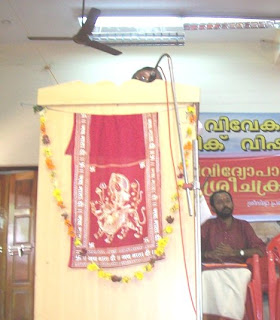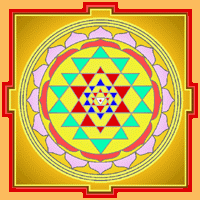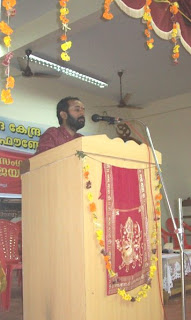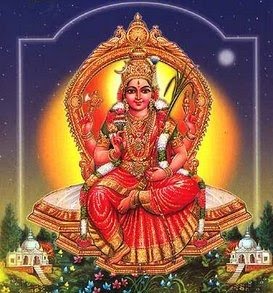Iam presenting an outline of the subject I cannot reveal the full article because Ive discussed the nuances of Sastha Moola Mantram, which I dont want to publish in this open forum.
 Speaking for hundreds and hundreds of yugas with His thousand mouths, Lord Shesha cannot complete describing the Glory of Lord Sastha-
Speaking for hundreds and hundreds of yugas with His thousand mouths, Lord Shesha cannot complete describing the Glory of Lord Sastha-That being the case, a person like me will still dare to speak about Sastha and Srividya, relying solely on the grace of Sri Gurukrupa.
Lord Maha Sastha, known popularly as Hariharaputra, is the master in the age of Kali. He is praised as Pratyaksham Tu Kalau, Kalau Shasthru Vinayakau and Kaliyuga Pratyaksham
Paraabhattaarikaa Mahatripurasundari is the goddess of Supreme Beauty and Wisdom who pervades the three functional aspects of manifestation. The principal form of worship of Shakti is Shri Vidya
Son of Lalithambika
Though He is known as Hariharaputra, many will be surprised to know that Sastha is the dear most son of Lalitha and the upasana of Sastha is always in Line with Shrividyopasana...
Lalitha ParaBhattarika is none other than Maha Vishnu and there is no betham in between these two. If one sees the Bhasyam of Namavali such as Govindarupini -- Devi in the form of maha vishnu , Gopthri -- the operator or the maintenance of the universe who is Devi as Maha Vishnu, As in Narayini -- the shakti related to Narayanan or Mahavishnu. Narayini Sthuthi in Durga Sapthasathi calls her Vishnu Maya. Mukunda – one who gives Salvation Mukthi
Now though Sastha is commonly known as Hariharaputhra. It will be interesting to know the relationship between Sastha and Lalithambika. You can see an explicit reference of Sastha in Lalithopakhyana, as the Son of Lalitha Parameshwari.
In Lalithopakhyana, there is a detailed description about the Mohini Avathara. Prakruthi is Lalithamba’s her first incarnation says Lalithopakhyanam. Mohini is Her second incarnation. Yes ! during the amrutha madhanam, when there was a commotion between the Devas and Asuras, Lord Vishnu went to a secluded spot and started meditation of Sri Lalita Devi, who dwells within Him as the aspect of power. Due to this meditation he manifested as a form of Lalita Devi. Taking this incarnation as an embodiment of
eroticism, Vishnu approached the celestials and demons.
thasyam vai janayaamaasa saasthaaram asuraardhanam
So Sastha is considered to be the dear most Son of Lalithambika.
There are many more interesting facts in support of this.. Devi is attributed as "Aapeena Vakshoruhaam". Even for Ganapaty and Subramanya he fed the breast milk only through a cup. But the aspect of Shri Matha was well established with Sastha himself. After the divine incarnation of Sastha, Vishnu returned back to his original from from the Mohini Avathara. Sastha, as a child, began to weep for his parents. This outwardly appears to be a mere childish action, but it was the divine leela to establish the motherhood of Lalithambika. The real mother – Shri Matha fondled with Sastha and suckled him with the milk of wisdom.
Sastha was breast fed by Lalithambika herself.. This incident is very much clearly recorded in books like Kanchi Puranam, Kamakshi Vilasam and Devi Parakramam.
Srividya – Kanchi and Sastha
nagareShu kAnchI – says Bharavi, the author of the great classic – kirAtArjunIya, praising Kanchi as the greatest of cities. It is the only Mokshapuri in Southern India –Kanchi literally means the ornament worn by women around their girdle – called Oddiyana. Kanchi is the foremost Shakti Pitha – called Mahoddyana Pitha (Kamarupa – Assam, Jalandhara – Jalandhar and Purnagiri – Badari being the others). This Peetha is presided over by Sri Charyanandanatha and Sri Parabhattarika themselves as Maha Gurumurtis.
 Kanchi is also considered the Nabhi Sthanam or the navel of the Brahmanda. As we know, the navel is the point of origin for all nAdis in the body and is considered to be the storehouse of power. Sri Kamakshi being the source of power for all Devi and Devatas in the world, Kanchi is rightly called the Nabhi Sthana. Sri Lakshmidharacharya in his Samvit Stuti says thus: `O Samvidrupini! At Nabhi Mandala of the Brahmanda, beyond the regions of darkness (i.e. Muladhara and Swadhishthana), you appear as the lightening of parA samvit, hoding pAsha and AMkusha in your hands, seated on Kamakoti Simhasana'.
Kanchi is also considered the Nabhi Sthanam or the navel of the Brahmanda. As we know, the navel is the point of origin for all nAdis in the body and is considered to be the storehouse of power. Sri Kamakshi being the source of power for all Devi and Devatas in the world, Kanchi is rightly called the Nabhi Sthana. Sri Lakshmidharacharya in his Samvit Stuti says thus: `O Samvidrupini! At Nabhi Mandala of the Brahmanda, beyond the regions of darkness (i.e. Muladhara and Swadhishthana), you appear as the lightening of parA samvit, hoding pAsha and AMkusha in your hands, seated on Kamakoti Simhasana'.Sri Lalita Sahasranama describes the greatness of Kamakoti with the names - kAmakoTikA and kAmAkShI. Sri Bhaskararaya comments thus on the name `kAmAkShi' - it is the extraordinary name of the deity who presides over Sri Kamakoti Peetha. Lalitopakhyana of Brahmanda Purana describes the glory of Kanchi and names it as the holy place where the Upadesha of Sri Lalita Sahasranama was given by Lord Hayagriva to sage Agastya.
Every Shrividyopasaka will know that the physical form of Laitha parameswari can be witnessed only at Kanchipuram. It is her Rajadhani... Lalitha parameshwari's headquarters is Kanchipuram - the Shri Nagaram of Bhuloka.. The whole of Kanchi Kshetram is Shrichakraakara(in the form of Shri Chakram). And the Bindu is Kamakshi Sannidhanam.. And an interesting fact the unknown fact is that Right behind Kamakshi is her beloved son with his consorts.. Poorna and Pushkala. We may all know that the position of Guru is our Shri Chakra Puaja Paddathi is right behind the Bindu - the sthanam of Devi. The city of Kanchi itself is in the shape of Srichakra with the Garbha Grha of Amba forming the Maha Bindu. Sri Kamakshi represents pure Parabrahman.
When the whole Kanchi Mandalam is considered as Shri Chakram - Lalitha Parameswari's Sanctum is the Bindu and Sastha's position is right behind the bindu. Ie the position of the Guru.
The upasana of Sastha in the Shrividya cult is maintained with utmost secrecy that too only with a few specific schools of Shri Vidya... In general the practice of Srividya - in the Saubhagya Vidya of Dakshinamnaya one can find Sasthru moorthi. Sastha, (w.r.t to this area) helps the upasakas in begetting children and to overcome the enemies. In the Sadi Vidya - Sastha is one of the Gurus in the Ogatraya
Dharshana Kramam
It is a practice of great shrividyopaskas entering the Kanchi Kshetram must worship all the deities with due Mudras and mantras (iam not explaining the deities and the mudras in this blog) and Finally, one should worship shAstA with the his moola mantra and display khaDga, pAsha, karavAla and other mudrAs and conclude the dharshanam at his Sannidhanam.
Sastha and Sri Chakra
It will be interesting to note that there are a set of songs very much popular in Kerala known as Sastha Paattu. It is a 17th century anthology of Tamil religious songs dedicated to Lord Sastha, written by the poet-saint known as VeeramaniDasar. These songs are known both for its poetical and musical qualities, and for its religious, moral and philosophical content.
Shri.Manidasar belonged to the illustrious Kambankudi family who lived in Melilla near Punalur. He was an ardent Sri Vidyopasaka. He exclaims the glory of the Lord and concludes his songs praising "the son of Lalitha".
Or aarum vimsathiyum or dasamum or eezhum seerai inai seernthu sri purathil vaazhum engal paaraalum lalithai petra balaka
Surprisingly these songs are very much available in Kerala and and these Tamil songs are written in Malayalam script and in Tamilnadu it is known only to a handful of few. The songs also include detailed description of Shri Nagara, Chintamani Griha and the devatas who surround Lalitheswari.
The source of inspiration for all these songs came from a small hamlet in the banks of Thampraparani - known as Karanthapuri. It will be very interesting to know the fact the power house of all the Sastha Kshetrams lie here. The unique worship of Lord Sastha is known as Sastha Preethi actually originated from here. The Kulathooril Ayyan there is worshipped not in the form of a vigraham but in a stone peeta with a beautiful Shri Chakram engraved on it. The Srichakra established is free from scratches to this day and every line is crystal clear even after innumerable years. I have been blessed to see the Srichakra personally and it is amazing to see the clarity of lines in the Srichakra
 Even at Sabarimala - the ultimate temple of Sastha among the devotees - the Lord is seated on a Srichakram and not on a Sasthru Yantram. Till few years ago there was a practice of chanting Lalitha Sahasranamam inside the manimandapam which has come to a cease very recently for reasons unknown.
Even at Sabarimala - the ultimate temple of Sastha among the devotees - the Lord is seated on a Srichakram and not on a Sasthru Yantram. Till few years ago there was a practice of chanting Lalitha Sahasranamam inside the manimandapam which has come to a cease very recently for reasons unknown.There is also an exact Navavarana Puja kramam for Sastha fitting the Sri Chakram’s 9 avaranas. The Pravesha Krama goes from innermost bindu to the Bhupura. In the Bindu is seated Poorna Pushkala Samedha Maha Sastha, around the Trikonas are Dharma Sastha, Asithanga Bhairava and Vyagrapadha and similarly there are 9 avarana devatas exactly like Lalitambika
Srividya Kshetram
Many temples which is associated with the Srividya cult definitely has Sastha with them. You may be the mooladhara kshetram Thiruvarur is "Srividya Temple" in other words. Here the temple dharshan is done exactly like the Srividya deeksha kramam. It starts with 28 lettered Maha Ganapathy sannidhi and all the Srividya Devatas including Matruka aksharas are housed in each shrines. Lord Vanmeeka natha is Sadhashiva here and Lord Thyagaraja is "Shiva - Shaktyaikya Swarupini". The alankaram here shows only the face of Lord Shiva and Shakti and the Paada Darshanam is shown only during the Pankuni Uthram day. The uniqueness of this paada Darshanam is - the right leg of shiva and the left leg of devi alone is shown. And the more interesting fact is if one takes a pradakshinam and looks at the back side of the vigraham - its a single pinnal jadai - hair dressing of a woman.
And then comes Kamalambika sannidhi. And at the very entrace of Kamalambika welcomes Sastha. One has to worship Sastha and only then proceed to devi Sannidhi. Kamalambika is the ultimate Kamakala Swarupini. Ucchishta ganapati the mula virat swarupa of Kamakala is also seen in front of devi.
Muthuswami Deek****ar a great Srividyopasaka sees no difference between Sastha and Lalithambika - in his Kruthi Hariharaputram, says "pushpa SarEkshu kArmuka dharaM" - Sastha is visualised as three eyed, clad in red, Having Pushpa Saram, Ikshu Kodhandam and having the ratna chashakam.
Upasana Kramam
Interestingly the Sahasranama of Sastha has many unique namas which is exclusive only to Srividya kramam. Example,
Pancha Brahma Parayanaya, Kubjika Mantra Vigrahaya, Hreemkaraya, Hreem Manase, Hreemkara Rasa pesalaya, Humkara Kruthi Su Prabhave, Bindu Priyaya Nama, Baindavasanaya
And apart from this there is an exclusive puja Paddathi for Sastha which has everything similar to that of Lalitha kramam. My Paramaguru who was an exponent in Srividya (whose kuladevata was Shasta) worshipped the Lord 100% with the Srividyopasana paddathi.
In our Sasthru Guru parampara, I was able to trace out and find out many more hidden treasures in the near past. Right from Pratha Smaranam, Snana Vidhi, Thantrika Sandhya, Pathraasadhanam, Chathushshashti Upacharam, Navavarana Puja and even Vishesha Argyam. – everything we have exclusively for Sastha

And even the Mantra upadesha kramam is more or less Similar to Shrividya Kramam.
In Shri Vidya after Ganapathy, its Bala Mantra upadesham. Then comes Matangi and Varahi who are the Mantri and Senapathi of Lalithamba. Correspondingly Bhuvaneshwari and Chandika Mantropadesham is given and then leading to Panchadashi and Paduka Deeksha.
Interestingly the upadesha kramam we follow for Sasthru Upasana is equated to the same order.
It starts similarly with Ganapaty; Like Bala who is the daughter of Lalithambika its Satyaka Mantram, who is son of Lord Sastha. Then Bhoothesha and Krushnabha’s mantrams who are the Mantri and Senapathi of Sastha. Hariharaputra Mantram and Kiratha Sastha Mantram is given which both are stand alone mantras clubbed into Sasthru Upasana - similar to Bhuvaneshwari and Chandika included in Lalithopasana. Then comes Ashtakshari Sasthru Maha Mantram similar to Panchadasi and ends with Guru Paduka Deeksha.
Sasthru Moola Mantram
(please excusue me if this is a bit confusing... but I can not reveal the actual moola mantram here)
And finaly coming to Sasthru Moola mantram its XXX - XX - XXX
The first alphabet of Sasthru beejam is fourth Gha, Gha is an alphabet which is nothing but Shudda Vidya
Shudda Vidya is the 32nd Thathwam. So anything related to this signified by the number 32.
Shuddha vidyangurakara dwija pangthi dwayojjala - says Lalitha Sahasram
Lalithopakhyanam has 32 Chapters.
The ucchishta Ganapati upasana which is nothing but Srividya is same 32 lettered with the same Gha beejam
Shudda Vidya ie 32 is again signified in Maha PrAsada Avarana Puja.
Avarana krama for Maha prAsada Vidya is different from regular Srichakra Navavarana and is described in the Krama Tantras. Also, one should understand that the Maha Prasada Vidya does not refer to prAsAda bIjA – parAprAsAda or prAsAda parA, but instead to the 32-lettered vidyA – which is described as avidyAcChedinI or parA chintAmaNi in the Tantras. The AvaraNa procedure for mahA prAsAda, which is given along with mahA pAdukA during pUrNAbhiSheka in dakShiNAchAra sampradayas.
Most of the Srividya Upasakas perform the Maha Prasada pUjA in Srichakra itself, visualizing the Avaranas as described in Kubjika Tantra. The Maha Prasada Aavarana puja has Sastha in the Ninth Avarana.
Interestingly this Shudda Vidya 32 is signified in all the different Sastha Mantras.
ie Harihara Putra Mantram (the one which is suppose to give Putra Labha and Shatrnu Nashanam) is 32 lettered.
The Abheeshta Varadha Sastha Mantram given by Raivatha Rishi (in the book Mantra Mahodathi by Mahidara) is 32 lettered
Another popular Mantram of Sastha starting with "Sarvagnja" is also 32 lettered.
And Coming Back to our Ashtakshara Maha Vidya of Sasth,
GHA is Shudda Vidya
When the Para Shivam which is without Chalanam developes a desire it is called Sadha Shivam. This Sadha Shivam's Shakthi is shudda vidya. Shuddha vidyA - the condition which is operating upon sadAshivam, causing it to identify itself with the phenomenal world.
Next part of the beejam – is Agni thathwam. In pancha bootha thathwam this signifies Pradhama Dravyam ie Vishesha Argyam. In other words all the things related to puja – the dravyams for Bahya Puja.
The next part indicates left ear ie the Nivruthi Margam. Ie the puja done within – Athma Vicharam or Anthar Muka Samaradhya.
A Lotus exists in water but the water doesnot stick to the Lotus leaf. But without water it cannot exist. Here in this state this bedha buddhi is Maya. The ultimate one is seen as two entities.
So in a Upasana - both the Margas are complementing with each other. Once cannot exist without the other. Even Lalitha Sahasranama says Bahir Mukha Sudurlapa (it desnt says its tmpossible - it says its a little difficult)

When u think of any divine form inside – you contemplate on him and the same is installed on a Vigraham or a Picture outside and its worshipped. So what is done inside is done outside. The Same is Shudda Vidya.
So when the Supreme One becomes Two because of bedha buddhi – it is approached both through Chidda Shuddi and Bhahya Puja. This is XXX - Sastha's beejam
Na ma: - understand Iam not this Jeevan
XXX - XXX - Iam the Supreme Secret –ie knowing the Self - Atman
This is XXX XX XXX
The Supreme One is divided into two because of bedha buddhi. So by internal and external puja one has to understand that he is not the jeevan but the Supreme being.
This is the goal of Srividyopasana and the Same is Sasthru Vidya
Sastha Upasana is nothing but Srividya.
Before coming to this programme yesterday I had an opportunity to goto Kanchipuram to have the Darshan of Shri Lalitheswari. To my total surprise, the new Pancha Brahmasana made for her, kept for Lord Sastha.
Lord Maha Sastha was seated on Pancha Brahmasana surrounded by the 15 Nitya Devis as if showing me my mother Lalitha and her Laalitha Sudha – Sastha both are one and the same.



 Connection of Sastha with Srividya Upasana
Connection of Sastha with Srividya Upasana 




Excellent Swami.
ReplyLogamatha Shri Adi Parashakthi Amme..Sharanam Ayyappa
"श्री-शिवा-शिव-शक्तैक्य-रूपिणी-ललिताम्बिका"
It is indeed the duty of a serious sadhaka to protect and perpetuate the sacred and secret traditions of Sanatana Vaidika Parampara.
Happy to note the contents.
I am a 5th generation disciple of Shree Bhaskararaya.